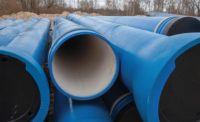Corrosion of metals is an ever-present problem in the plumbing industry. Common piping materials such as copper, steel and cast iron are readily oxidized and thus undergo aqueous corrosion at a rate according to the corrosion potential of the service environment.
However, corrosion is not normally a problem in well-designed and -managed systems. Careful corrosion engineering management, including attention to details such as materials selection, fluid mechanics, water-chemistry control, protective coatings, cathodic protection and suitable material corrosion allowance should ensure these materials comfortably survive their design life.
These details should be addressed not only during the initial design but also when any significant changes from the design are implemented during construction or modifications to the service environment are contemplated over the life of the system.
Erosion corrosion
Seamless copper tubing conforming to ASTM B88 has been the most common material for small-diameter potable water plumbing systems because of its ease of installation, corrosion resistance and relative low cost.
Clean copper surfaces are reactive with water and can form cuprite (Cu2O) or tenorite (CuO). In distilled or soft water, copper tubes can corrode at rates of up to 5 mm per year, depending on the oxygen and carbon dioxide content of the water. However, minerals in water usually form insoluble scales such as carbonates, nitrates and sulfates on tube interiors. This scale acts as a protective film to the copper surface, resulting in corrosion rates as low as 0.2 mm per year. The scaling potential of a water source is readily predicted from its chemistry, using indices such as the Langelier Saturation Index.
Mineral scale in copper tubing is chemically stable and under normal plumbing conditions would be expected to remain as a protective layer for the service life of the system. Scale is mechanically weak and vulnerable to damage by high-water velocity or cavitation. Entrained solids and bubbles in the water can impinge upon the scale, causing local fracturing of the mineral layers and exposing the copper surface. This results in a sharp increase in the local corrosion rate where the protective scale has been removed.
Degradation of copper tubing by this mechanism is known as erosion corrosion and is readily identified by U-shaped pits in the tube interior, oriented in the direction of water flow (Figure 1).
Water velocity is the principal variable that can initiate erosion corrosion. The stability of the scale also is dependent on the water temperature. The Copper Development Association recommends the water velocity in a copper tube be limited to 8 ft. per second for cold water systems, 5 ft. per second for hot-water systems less than 140° F, and 3 ft. per second for higher temperatures.
Turbulence in the water flow, which can be caused by abrupt changes in the piping system, also can initiate erosion corrosion. Therefore, careful sizing of tubes, adequate separation of valves and minimization of bends can mitigate this phenomenon.
Unfortunately, changes to the plumbing system unforeseen by the design engineer can cause erosion corrosion. Installation defects, such as lack of reaming of tube ends where burrs inside tubes protrude to interrupt laminar flow along the tube, can cause local cavitation and erosion corrosion downstream of the burrs. Protrusions into the flow stream, such as excessive solder lumps or incorrectly fabricated tees also can cause local turbulence.
Here is an investigation into corrosion for a system where an oversized recirculating pump was substituted during installation, resulting in excessive flow and erosion corrosion. (Figure 2).
It is essential for copper tubing systems that good quality control is maintained during fabrication and that any deviation from the original design is reviewed from a corrosion engineering perspective.
Corrosion of galvanized pipe
Galvanized piping employing grooved couplings commonly is used in larger-diameter systems, as it provides a fabricated and economical system. Hot-dipped zinc-galvanized coatings allow for good corrosion protection to steel substrates, as zinc typically corrodes by a factor of 10 to 100 times slower than steel. Also, it provides additional galvanic protection on damaged surfaces where the steel substrate is exposed, as the zinc corrodes preferentially.
The hot-dipped process produces a layer of intermetallic phases on the steel surface for good adhesion of the zinc coating. Galvanized pipe is best used for untreated cold-water systems as the corrosion rate of zinc is increased at higher temperatures and by softened water.
Zinc tends to corrode in a uniform manner in water. Properly galvanized pipe, conforming to standards such as ASTM A53, can be expected to last more than 50 years. However, the corrosion mechanism of zinc is strongly influenced by the anions present in solution. Deionized or acid waters can cause local pitting corrosion, which can quickly penetrate a protective coating.
Microbial-induced corrosion can occur when microbes form biofilms on the inside of a pipe. Once a surface film forms to insulate these colonies from water flowing in the pipe, the local water chemistry is changed and biological activity of these microbes can produce acids, which attack galvanized coatings. Under-deposit corrosion is a common mechanism where these biofilms grow under protective layers of scale.
MIC corrosion most likely initiates in stagnant water, therefore systems should not be subjected to long periods of standing water unless steps are taken to preclude the initiation of MIC. For example, systems not placed into service soon after pressure testing should be sanitized by chlorination, drained of the test water or both.
Here is an investigation into the corrosion of a plumbing system in a sports stadium, which contained more than two miles of galvanized pipe. Only three years after installation, significant corrosion of the galvanized coating had occurred, leading to rust-colored water and leaks. Inspection of the pipe interiors revealed that in the cold-water pipe, the galvanized coating was mostly intact, but was occasionally pitted (Figure 3).
“Beach” lines were visible, indicating the pipes were sitting in a partially filled condition for a considerable period of time. Laboratory tests confirmed the presence of sulfate-reducing bacteria in these corroded areas. Metallurgical analysis of the pipe revealed the zinc coating was failing by pitting corrosion (Figure 4).
In accordance with the local plumbing code, the original design of the piping system specified the pipe would be flushed and drained after pressure testing. However, because of a plumbing contractor change during construction, this operation did not occur and the piping was left partially filled with stagnant water for up to a year before operation. Galvanized coating on the pipe interior cannot be effectively repaired, so the pipes were replaced at a multi-million-dollar expense. This is a good example of catastrophic corrosion that can occur from a deviation from the original specifications during construction.
Graphitic corrosion
Cast iron has been used as a piping material for centuries and in a nonaggressive environment can be expected to have a long lifetime. Unalloyed, gray cast iron, which consists of graphite flakes in a ferrite matrix, is the traditional form of cast iron.
Ductile cast iron, which is alloyed with magnesium to produce a spheroidal graphite microstructure, is now the most common cast iron used for water distribution systems, owing to its superior impact and fatigue resistance. In hard water, internal corrosion rates are very low because of the formation of protective calcium carbonate scales. Most buried cast-iron pipes fail from external corrosion because of contact with aggressive soils or microbial activity, which produces pitting failure.
For internal plumbing systems, gray cast iron is still used for drain-waste-vent systems due to its long lifetime and sound-insulating properties. Although the aqueous corrosion rate of gray cast iron is low, the material is susceptible to a selective leaching mechanism known as graphitic corrosion, because of galvanic cells forming between the graphite flakes and ferrite matrix. Iron is leached from the surface of the material leaving behind a brittle graphite material with no dimensional change but low structural integrity. This graphitic corrosion mechanism is accelerated by microbial activity.
Here is an investigation into an apartment complex built in the 1940s using a gray cast-iron DWV system. A survey revealed that although the vent and waste pipes were generally in good condition, many of the drains from kitchen units were severely corroded. All corrosion was on the internal surface of the pipes and the mechanism was found to be graphitic corrosion (Figure 5), accelerated by the presence of sulfate-reducing bacteria.
There is evidence that the corrosion rate has increased within the last 20 years, as recent pipe replacements appear to be corroded at a faster rate than the original pipe. This corresponds to the installation of dishwaters in the apartments in the 1980s. It is postulated that excess water-softened salts and detergent have reduced the presence of protective scale and grease films on the pipe walls, resulting in the increased corrosion rates. This is a good example of an environment that has changed during the lifetime of the component.
A well-designed, properly installed and operated system should be expected to corrode at a rate that will not be problematic during its design lifetime. However, system modifications during construction or changes to the environment over the lifetime of a system, such as variations in flow conditions, water chemistry or biology, can sometimes produce unexpected corrosion events to occur.
The design engineer should consider possible variations in the plumbing system service environment, as the cost of building additional redundancy into the system is small compared to the cost of repairing corroded materials. However, since all possible future variations cannot be predicted, it is essential that a corrosion engineering assessment is undertaken when significant changes in the plumbing system or service conditions are contemplated.
Alan Humphreys, Ph.D., is a metallurgist in Simpson Gumpertz & Heger Inc.’s (SGH’s) engineering mechanics and infrastructure group, and he has more than 15 years of experience in materials engineering. He specializes in the failure analysis and structural assessment of materials systems that have degraded by mechanisms such as corrosion, fracture/fatigue or wear.
Phillip Sharff,P.E., LEED AP is a structural consultant specializing in the performance of underground structures, piping systems, building and mechanical components, industrial structures and structural materials. He has conducted numerous studies using the finite-element method to analyze structural behavior and to investigate structural failures.






